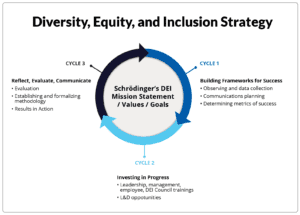As we close 2021, diversity, equity and inclusion (DEI) is a phrase we have all heard in passing, but the question is: do we know what it really means and how to instill these values in the workplace?
For some, it may mean the ability to work effectively with one another regardless of backgrounds or differences, or it may mean the value of having diverse representations and perspectives across teams. For others, it may mean embracing different backgrounds and experiences to make sure that all individuals are able to succeed in the workplace.
In fact, DEI is a culmination of all of these meanings.
There are three pillars that comprise DEI:
- Diversity: The representation of all of our varied identities and differences collectively and as individuals.
- Equity: Ensuring fair treatment and equality of opportunity for all employees.
- Inclusion: The philosophy or a management style that actively invites the contribution and participation of all people.
At Schrödinger, DEI is a top priority and supports a most important aim: to ensure that all employees feel safe, comfortable and valued. Those are the types of employees who are far more likely to stay at their respective companies and invest in them. Innovation, disruption and challenging the norm–the bold actions upon which great companies are built–rely on people to make them happen. Creating a workplace environment that embraces its people and their diversity of opinions and ideas empowers more individuals to take action, ultimately fostering more creativity, novel ways of thinking, better problem solving and greater perspective within an organization.
These are fundamental assets to any organization, especially in the life science and material science industries where pushing the boundaries of what is possible in science every day is the only road to progress. That is one of the many reasons why we are dedicated to ensuring an inclusive environment for everyone. Our mission is to intentionally create a workplace that is fair, respectful and mutually beneficial for all employees by actualizing and championing our shared values of science, teamwork, respect, innovation, and veracity in debate and empowerment.

But outlining the benefits of DEI initiatives is just the starting point. Making DEI initiatives a reality within an organization requires tremendous planning, input and action.
Our DEI strategy at Schrödinger is simple: a cyclical methodology focusing on specific challenges and issues that come up at our company and the industry. We have found two areas to be particularly helpful as we navigate our DEI journey, and I believe that it’s possible for any company to replicate some of what we have learned and done on this front.
The development of ERGs, or Employee Resource Groups, to encourage the support and sharing of resources internally across Schrödinger, has been invaluable to our organization. Each ERG is a special interest or affinity group, like LGBTQ+ or POC for example, that provides community support while representing the interests of that group to the company. They’re not only meant to be a safe space for those who self-identify with certain groups to find support but also a place to show support. These groups actively work towards change and creating a place where employees can find professional and personal development, community outreach, networking and more.
We are also planning a partnership with NeuroLeadership Institute, a leadership development organization focused on bringing a more concrete, science-based approach to growing skills in business leaders, to offer our employees programs and tools to speak openly and safely about DEI at Schrödinger. The program, called DEI Starter Kit, is focused on three modules: Grow, Include and Decide. “Grow” tackles the fixed mindset that many of us find ourselves having, which limits us from going out of our comfort zones and being okay with making mistakes. “Include” asks employees to identify factors that put others and themselves in a state of exclusion, emphasizing and building relatedness among colleagues by looking for commonalities with those who are different from you. Finally, the “Decide” module is a mitigation tool that teaches us how to identify inherent bias towards others. We believe that any kind of structured course on DEI is a wonderful tool to help employees better understand the larger topic and to feel more comfortable to discuss openly.
Ultimately, for any company trying to elevate DEI internally, it has to start with giving employees more opportunities to have a safe space to connect on their differences or shared interests and educate themselves on what DEI is and what it should look like in the workplace.
At Schrödinger, our goal is to continue to iterate on strengths and overcome weaknesses to become better allies, better champions and better people. We’ve found that focusing on qualitative goals rather than quantitative goals, deliberately challenging the traditional norm around DEI in corporate life, is an effective path forward. We are dedicated to continuing to improve, learn and grow from each other to ensure diversity, equity, and inclusion for all.









